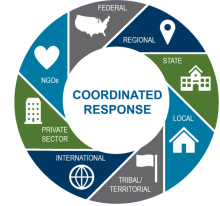Clear, coordinated, and reliable communications are essential to the effectiveness of any disaster response. There are, however, certain aspects of chemical incidents and public and responder reactions to them that make chemical incident responses especially vulnerable to communications failures, with the potential for dire consequences for human and environmental health and safety. In particular, chemical incidents often occur with little or no warning, and minutes can matter for the preservation or protection of human health and the environment. Communications delays, coupled with the public’s and responders’ misperceptions or gaps in knowledge regarding the uses, risks, and behaviors of chemicals, can cause these groups to act in ways that unknowingly put the health and safety of themselves or others in danger.
During a chemical incident, failures in communications processes and systems that hinder coordination between responding partners can result in more individuals being exposed and prevent first responder and public health system components from functioning as a team. Past chemical incidents have revealed several critical areas that emergency communications planners must consider. Firstly, the capacities of communications technologies are likely to be strained to the breaking point by extreme levels of use during a large-scale chemical incident. Secondly, it is essential that first responders and first receivers are privy to timely, accurate information so that they can provide appropriate care for survivors while keeping themselves safe. Further, robust, real-time, multi-directional communications capabilities connecting first responders with hospitals, the public health department, environmental safety officials, and laboratories are needed. Finally, forming relationships ahead of incidents with local experts that can be called upon to quickly assist in a chemical incident response will benefit risk mitigation efforts. In chemical emergencies, the immediate availability of the right expertise—from toxicologists, warfare agent specialists, poison control centers, chemical facilities, research centers, etc.—can be key to avoiding delays in the identification of the toxic substance involved and the timely transmission of essential lifesaving information throughout the emergency response system. The consequences of these types of communications failures during a chemical incident were highlighted in the aftermath of Aum Shinrikyo’s 1995 attack in the Tokyo subway with the chemical warfare agent sarin,22 described below. The considerations outlined in this KPF provide strategies to avoid these and other communications failures in chemical incidents.
Achieving success in chemical incident response and recovery often requires cooperation and coordination of a host of governmental and NGO departments and agencies and with private organizations. Robust communications processes and integrated operations systems enable the coordination of response and recovery efforts between and among federal, state, local, tribal, and territorial (FSLTT) departments and agencies as well as private and non-governmental organizations. Communications stakeholders include personnel in public health and healthcare, emergency medical services, emergency management, law enforcement, civic leaders, and environmental safety, among various others depending upon the specifics of the incident scenario. This KPF describes the importance of developing, coordinating, and communicating chemical incident-specific messages for the affected population and the community at large, as well as the coordination of communication between the multiple potentially involved response and recovery agencies. Advance planning can facilitate timely, consistent messaging across all levels of government, the private sector, and the general public throughout response and recovery processes, thereby building public trust and leading to better community-wide response and recovery outcomes.

Footnotes
22. Levy, L., Smithson, A.E. (2000). Rethinking the Lessons of Tokyo. Ataxia: The Chemical and Biological Terrorism Threat and the US Response Stimson Report 35. (pp. 71-111). Global Health Security.

